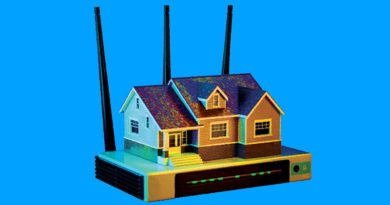Low Latency and You!
By Leslie Ellis
As the bandwidth builders amongst us advance the quest of multi-gigabit networks, a corollary term is emerging: “low latency.” Two words, always expressed together, in a semantic mashup that almost warrants removing the space between the two words: lowlatency.
It’s a term that’s been around for as long as communications networks, as a way to measure how quickly bits move (or not) from one place to another. Or, as one engineering colleague put it, “latency is the sum total of all delays in a network that impeded a request from receiving an instantaneous response.”
“Low latency” is making the rounds with gusto these days because of developments like 5G, on the mobile side, and 10G, from the industry we used to call “cable.” (Refresher: the “G” in “5G” stands for “generation,” and the “G” in “10G” stands for gigabits.) Both target latency figures in the neighborhood of 1 millisecond, which is one one-thousandth of a second.
Latency is one of those terms that gets bunched up with “throughput” and “speed,” which are neither synonymous, nor the easiest concepts to wrap the head around. For that reason, I’ve been poking around for clarification in my usual non-scientific way. Which is to say posting queries on Facebook that start with “Dear Tech Friends” — for two years now, off and on.
Here’s a sampling of what our engineering pals came back with, when asked about the meaning of low latency: “high responsivity,” “fast response,” “near-real-time.” “fast-transit,” “high simultaneity,” “fast responsivity.”
What Latency Is (And Isn’t)
If latency is the time it takes to move a packet from source to destination, throughput is the number of packets moved from source to destination, in a given amount of time (megabits per second/Mbps; gigabits per second/Gbps.) It follows that when a network’s latency is low, its throughput is generally high.
It’s when a network’s latency is high that the grumblings begin — about lags and delays. In particular, high network latency tests our tolerance for delays in the Internet-connected stuff we’re using. Remember the early days of doorbell cameras? Somebody’s at the door. The alert pops up from the doorbell’s app. You engage, to see who’s there. Instead you see a package on the ground, and hear the UPS truck trundling off. That’s a latency issue.
Another example: Anything you used to do locally on your computer, but now do “from the cloud.” The most vexing example here in the Geek-o-Sphere involves a recent upgrade to Office365. Tasks that used to take milliseconds – opening a file, saving it, searching it – suddenly take as long as 10 seconds. After a while, this can really mess with a normally sunny disposition.
One afternoon, after about the 50th time I’d chided myself for being impatient, I did the math. Cloud lag, or, the opposite of low latency, adds up to about an hour a week, and that’s just for one application (Word). Harrumph!
Latency Fundamentals
Here’s a fact, perhaps obvious, about network latency: It can’t be less than zero. This is similar to why we can’t fast forward live television: The future hasn’t happened yet. It follows that you can’t receive a packet before it was sent.
In networks, distance is one contributor to latency, which is why you hear so much talk about “the edge.” For every 200 miles a packet travels, at light speed, it accumulates about one millisecond of latency. Hence why heavy gamers are happiest when the servers they’re tapping are geographically as close to them as possible. The closer you are to the “edge” of the network, the lower the latency.
This is also why cable’s edge is so coveted: That “last mile” access network is about as close as anybody’s wires gets, in terms of connecting homes and businesses. Technically, the twisted-pair telephone network is also about as “close to the edge” as any access network can get to homes and businesses, but compared to coaxial cable, and from a capacity perspective, its anemic…which explains why the nation’s major telcos are in hot pursuit of wireless techniques, like 5G.
This is also why it’s always a good idea to ask, when someone drops “the edge” into a conversation, where his or her edge is. Everyone’s “edge” is different! There’s the edge at the end of the core, and the edge at the output of the gateway, for instance. Also, be prepared for at least one wise-crack involving U2, because engineers are funny that way. My personal favorite nerdy quip about network edges, from way back in 2005: “It’s where the bits fall off.”
Other factors that contribute to network latency, regardless of where the edge is: Impairments. Fail-overs. Caches. Buffer overflows. Fat fingers. High demand. A lot of gremlins tend to be in the path from here to there, and they’re determined to slow things down.
Latency Beyond Gaming
What needs low latency? Here’s where it gets interesting, at least for those of us who’ve long been looking for low latency use cases, beyond shooting the other guy faster in a computer game — which was pretty much the only answer, for a long time.
It’s interesting because of the simultaneous rise of the cloud (no pun intended) to handle some of the behind-the-scenes computing and storage needs of our connected stuff. Anything that needs to respond in near-real-time is a candidate for a low latency network. Of the ordinary, day-to-day web stuff we do, examples include suggestions and directions. If you’ve ever lost connectivity while relying on Google maps to get you where you’re going, you can relate.
Newer use cases for low latency involve augmented reality (AR) and virtual reality (VR), which work better when operating as close to real-time as possible. In VR lingo, this goes by “motion to photon latency,” and describes the amount of time between, say, you moving your head to the left, and the display moving the relevant images to the right. Get it wrong, and people notice in ways that can substantially lessen the desired experience. For that reason, most AR/VR systems seek latencies of 5 milliseconds or less.
Some “optical passthrough” AR systems, like Magic Leap, HoloLens and their ilk, overlay relevant information into real-world situations. And now this, from the Department of the Obvious: The real world happens in real time. For that reason, latency is even more noticeable in AR than in VR. The changes in the real-world happen with zero latency, so, the additional frames of reference (the AR) beyond real-time make the latency lag all the more obvious. Why did the real thing move, but its overlay/AR descriptor didn’t keep up?
Then there are the things of the Internet of Things. An increasing range of IoT sensors need low latency, like those that sense data from moving vehicles (and especially autonomously moving vehicles.) Or the sensors inside a robotic arm, as it performs surgery. Or the sensors that optimize transport routes and logistics. The list of examples grows daily.
That’s a quick walk around the block of the new network darling that is “low latency.” This topic tends to attract a lot of input and debate!
 Leslie Ellis,
Leslie Ellis,
President,
Ellis Edits Inc.
leslie@ellisedits.com
Leslie Ellis is a tech writer focused on explaining complex engineering stuff for people who have less of a natural interest than engineers. She’s perhaps best known (until now!) for her long-running weekly column in Multichannel News called “Translation Please.” She’s written two broadband dictionaries, one field guide to broadband, and is a behind-the-scenes tech translator for domestic and global service providers, networks, and suppliers. She’s served as board member of the Rocky Mountain chapter of the SCTE since 2015, and is a 2019 Cable Hall of Fame inductee.
Shutterstock




